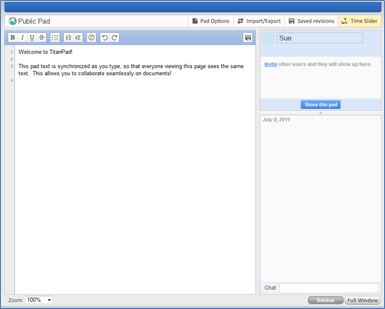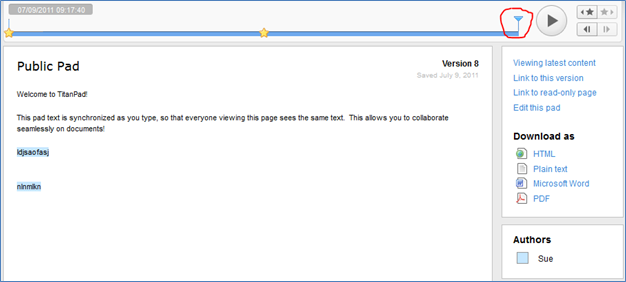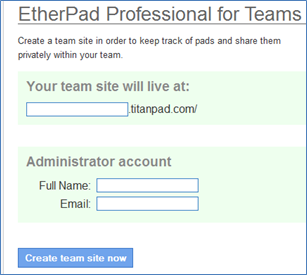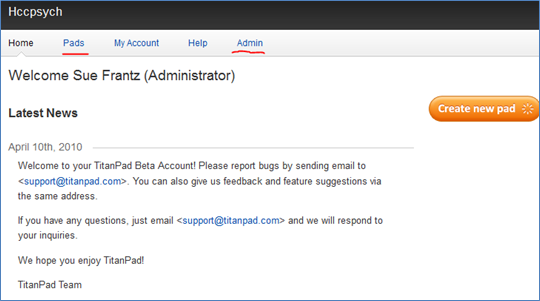TitanPad: Now with Private Space
TitanPad allows you to quickly collaborate. Create a public pad, copy the URL, and email it to your collaborators. They follow the link, then just start typing in the pad. In the top right corner, new visitors are assigned a color and are named “unnamed”. Clicking in the “unnamed” box will allow them to enter their name. Attached a name to a color allows you and your collaborators to see who added what. If others are logged in at the same time as you, you’ll see their changes as they type. Changes are automatically saved. With the chat window, text will stay there even when you leave. It’s a handy space for leaving messages for your collaborators.

When I last wrote about TitanPad two years ago, that was pretty much all there was to say. They’ve since added a lot of functionality.
Import/export. Import text from, say, a Word document. Or Export your TitanPad to, say, Word document.
Saved revisions. While TitanPad automatically saves, you can also create save points. Use this after a major revision so you can quickly restore to that revision at a later point if you’d like. With this pad, I clicked “save now” at two different points. Now, under “saved revisions” I have two restore points.

Time slider. Below is the time slider view. I can click on the circled bar to move it back in time, then I can click the play button to watch how the document changed over time. The stars designate when I hit “save now” to create a saved revision. But notice that with the time slider, you can move the slider anywhere I’d like, then click “link to” or “download as” to get that specific version.

The newest functionality, though, is the creation of a private space. In effect, the public pads are private. After all, you can only get to an existing pad if someone has given you the URL. But that also meant that you needed to bookmark the URL because that was the only way there was to get to a pad you created.
Now you can create a space where you and your collaborators can see the multiple pads you’re working on. Go to TitanPad and click on “Get your own private space” in the bottom right corner. Name your team site. For example, I might want a team site for my department – hccpsych. The URL I would give to my colleagues would be hccpsych.titanpad.com. Fill out the rest of the form, and click the “create team site now” button. [Note: Notice how it’s called EtherPad here? EtherPad was the original software. When it was no longer being supported, it kind of fell into the public domain. TitanPad was one group that adopted it.]

TitanPad will send you an email with a URL. Following it will take you to TitanPad where you’ll be asked to create a password. When you’re done, you’ll be taken to your main page. To add collaborators, click “Admin”, then “create new account.” To create a new pad, click “create new pad”. You can see all of the pads you’ve created with the “Pads” link.

The pads themselves operate the same way with the addition of two functions. You can name your pad. And there’s now a link at the top of that pad that lets you return to the list of pads you have for your team site.

I’m sometimes asked why use this instead of Dropbox. I use both. I use Dropbox for most storage and sharing of files. I like to use TitanPad for brainstorming, especially when others are editing at the same time. For example, we might be on a conference call, and we call up a TitanPad to take notes so we know we’re all on the same page. . A few times I’ve created a public pad, and sent the URL out on the teaching of psych listservs when I’ve been looking for new examples to use in class. With a public pad, people follow the URL, then just start typing. No login. No need to save. Just type and go.
Can you envision using TitanPad with your students? Maybe for small group work? It’s easy to learn how to use, and it’s easy to see who contributed what and when with the color coding and the time slider.